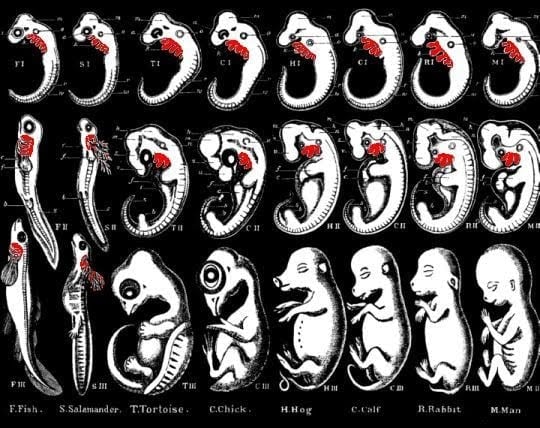- Comparative embryology is the branch of embryology that compares and contrasts embryos of different species, showing how all animals are related.
- Put simply, comparative embryology is the comparison of embryo development across species.
- All vertebrate embryos follow a common developmental path due to their common ancestry.
- They pass from single cells to multi-celled zygotes, clumps of cells called morulas, and hollow balls of cells called blastulas, before they differentiate, creating the organs and systems of the body.
- All have a set of very similar genes (the homeobox genes) that define their basic body plan.
- As they grow, the differences that will distinguish the embryos as adults become more and more apparent.
- The study of this development can yield insights into the process of evolution.

Image Source: SJC Year 12 Biology
Interesting Science Videos
Principles of Comparative Embryology
Karl Ernst von Baer, a Russian scientist, made observations on embryos of different species and came up with four principles of comparative embryology:
- General features appear before specialized features.
The first principle states that general characteristics appear earlier than specialized ones, and so a general, homologous structure would exist in the early embryos of groups of similar species. This would infer these organisms had a common ancestor, and different species “branched off” from it.
- General features progressively develop into more specialized features.
The second principle states that embryos develop from a simple structure to a complex organism. Von Baer argued against preformation with this theory, as it explains how embryos of similar groups of organisms developed in a similar way and differentiated from a similar structure, thus the organisms must be linked to a common ancestor.
Von Baer argued against the recapitulation theory with the third and fourth principles.
- Embryos of more evolved animals diverge more and more from those of more primitive animals.
According to the recapitulation theory, early human embryos have structures like gill slits, so, therefore, early human embryos represent the form of adult fish, which also have gill slits. Von Baer’s third principle argues that the presence of gill slits in human embryos is because humans and fish have a common ancestor, therefore supporting evolution.
- Embryos of higher animals resemble the embryos, but not the adults, of more primitive animals.
The fourth principle that describes the resemblance of different embryos of higher and primitive ones reaffirms the idea that higher animals are related to primitive animals, and must have shared an ancestor.
Significance of Comparative Embryology
- The field of comparative embryology aims to understand how embryos develop, and to research the inter-relatedness of animals.
- It has bolstered evolutionary theory by demonstrating that all vertebrates develop similarly and have a putative common ancestor.
- Scientists have used comparative embryology to study and gather evidence of evolution.
References
- Gilbert, S. F. (2000). Developmental biology. Sunderland, Mass: Sinauer Associates.
- Moore, K. L., Persaud, T. V. N., & Torchia, M. G. (2008). The developing human: Clinically oriented embryology. Philadelphia, PA: Saunders/Elsevier.
- https://www.ncbi.nlm.nih.gov/books/NBK9974/
- https://education.seattlepi.com/comparative-embryology-6455.html
- https://embryology.med.unsw.edu.au/embryology/index.php/K12_Comparative_Embryology
- https://www.pbs.org/wgbh/evolution/library/04/2/l_042_03.html
- http://eewevolution.weebly.com/comparative-embryology.html
